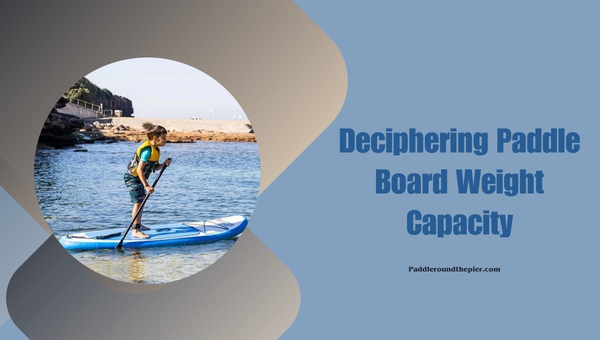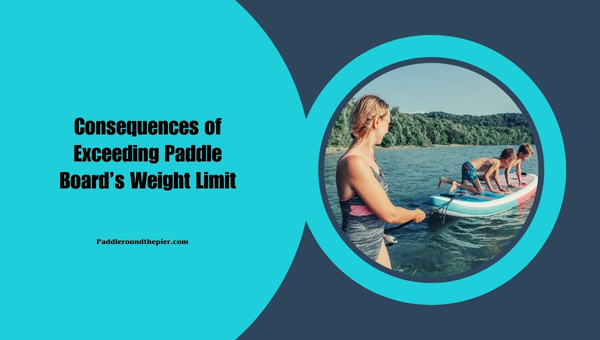Maximum Weight For Paddle Board: Understanding The Limits
When it comes to stand-up paddleboarding, understanding the maximum weight for paddle board isn't just beneficial—it's essential.
This article dives into everything you need to know, from deciphering paddleboard weight limits to determining manufacturer guidelines. Find out how these factors affect your performance on the water and can enhance your paddling experience.
The weight limit for a paddle board isn't just a random number set by the manufacturer. It is carefully calculated based on multiple factors, such as its dimensions and volume.
Most commonly, paddle boards carry an average weight ranging between 200 lbs (91 kg) to 300 lbs (136kg). However, this can vary considerably depending on the type of board in use.
Things You'll Learn Here:
- Understanding Paddle Board Weight Capacity: Why it's critical and its impacts on performance.
- Deciphering Manufacturer Guidelines: How do manufacturers determine the maximum weight for a paddle board?
- Selecting the Right Paddle Board Based On Weight: Factors one should consider while selecting.
- Consequences of Exceeding Weight Limit: Unveiling possible safety risks and performance issues.
Deciphering Paddle Board Weight Capacity
Before you can cruise smoothly on your paddle board, you must first understand a key factor: the maximum weight for a paddle board. No, it isn't a guideline you should take lightly or ignore—there's science and safety behind it.

What Are Paddle Board Weight Limits?
Let's kick off with the basics. The paddleboard weight limit is simply the maximum amount of weight that a particular stand-up paddleboard (SUP) can handle while still being safe and effective. This limit depends heavily on factors such as the board's design, material construction, size, and volume.
These limits aren't arbitrary rules set by manufacturers to make life more difficult. Far from that! They are established based on careful testing and research to ensure you get optimum performance from your SUP ride while simultaneously staying within safety boundaries.
Wondering how much weight can a paddle board hold? Well, typical recreational boards range between 200 – 250 lbs for a single paddler whereas larger tandem boards or specialty SUPs may allow greater weights up to 500 lbs or more.
Significance of Paddle Board Weight Limits
Knowledge about the weight capacity of paddleboards isn't just for bragging rights at gatherings with fellow enthusiasts—it has real implications for your experience out there in the water.
Here’s why understanding and abiding by these guidelines matter:
- Safety: Exceeding the suggested weight limit could lead to instability which might cause frequent falls or even capsizing, resulting in potential injuries.
- Performance: Adhering strictly to defined limits ensures optimal buoyancy and board performance.
- Durability: Overload over time will wear out your favorite SUP quicker than anticipated due to stressed materials.
- Ease of control: A correctly loaded SUP is simpler to steer thereby making your paddling experience more enjoyable.
Also Read: Paddleboard Parts: Your Guide to Essential Components
How to Determine Maximum Weight for Paddle Board?
When you're scouring the market for a good paddleboard, considering the paddleboard weight limit is non-negotiable and wondering how do you pinpoint this? The answer lies in two main considerations: manufacturer guidelines and the size/volume of the board itself.
Manufacturer Guidelines
Manufacturers don't just randomly stamp a maximum weight for paddle boards on their products. A lot goes behind these numbers to ensure user safety and optimal performance. Here's how they do it:
- Testing: Manufacturers meticulously test their paddleboards under various conditions to assess how much weight can a paddle board hold up against. They scrutinize its stability, maneuverability, and overall performance under these tests.
- Material Consideration: The type of materials used also influences the paddleboard's capacity. Boards made from robust materials like EPS foam and carbon fiber commonly have higher weight limits.
- Board Type: Lastly, different types of boards come with various capacities. For instance, touring boards usually carry more weight than an all-round or surfing board.
To help riders select an appropriate board, most manufacturers clearly indicate the maximum capacity on their product or their website.
Size and Volume Considerations
While manufacturer guidelines are certainly valuable, getting hands-on knowledge about how aspects like size and volume impact your standup paddleboard’s weight limit can be quite empowering.
- Board Length - Generally, longer boards tend to support more weight than shorter ones – they offer more surface area after all.
- Board Width - Wider boards provide better stability which often means they can handle more weight as well.
- Volume & Buoyancy - Another key aspect to look at is volume – which measures a board’s buoyancy or its ability to float on water when weighted down by rider(s) or gear.
It would help if you remembered that a board might technically stay afloat even after exceeding its maximum recommended weight limit, but it won't perform optimally.
So, understanding the interplay between size, volume, and design helps you make an informed decision about the paddleboard capacity well-suited to your needs. By heeding these guidelines and considerations, you can ensure safety and performance while enjoying the sport we all love.
Also Read: SUP with Dog Guide: Unleashing Fun on the Waterways
Selecting a Suitable Paddle Board Based on Weight
Selecting a paddle board involves more considerations than you might initially think. You can't just pick one because it has cool designs or vibrant colors. It's essential to take the maximum weight for the paddle board into account, among other things.
Factors to Consider
When choosing a suitable paddle board based on weight, there are quite a few points that we need to tick off our checklist:
- Rider's Weight: This is the no-brainer in the process. The maximum weight for paddle boards is always specified by manufacturers, so ensure your body weight falls well within those guidelines.
- Skill Level: If you're new to paddle boarding, picking a wider and longer board would be advisable as they provide more stability and make balancing easier.
- Intended Use: The type of activity influences your choice too. Are you planning to do yoga or fishing? Go for larger boards with higher weight capacity. If speed thrills you then narrow, lightweight boards would be better options here.
- Multiple Riders: Considering bringing your child or pet along? Make sure your board can accommodate extra weight without compromising balance and control.
Suggestions for Different Weights
Different weights necessitate different types of paddle boards. Here are my suggestions:
- For lighter individuals (<150 lbs): Smaller-sized boards ranging between 10 - 11 feet should work fine since they'd be easier to maneuver while providing enough floatation.
- Medium-sized individuals (150 - 200): A mid-sized board around 11 - 12 feet with good volume should suffice considering aspects of both maneuverability and floatation.
- Heavier individuals (>200 lbs): I'd suggest opting for larger boards which are around 12 -14 feet having higher volume and wider width ensuring stability while accommodating the increased load.
Also Read: Whitewater Kayaking 101 | Your Beginner's Essential Guide
Consequences of Exceeding Paddle Board’s Weight Limit
As a paddleboard enthusiast, it's not just about understanding the maximum weight for paddle paddleboard; there can be alarming consequences when you go beyond those limits. Let's take some time to discuss these outcomes in terms of performance impact and safety risks.

Impact on Performance
The first and most noticeable effect of overloading a paddle board is its impact on performance. Going beyond the paddleboard weight limit influences two significant areas:
- Maneuverability: The more crowded your board gets, the harder it is to control. An overloaded paddleboard fails to respond well to steering strokes, making it tricky to navigate around obstacles or change direction swiftly.
- Control: Stability and balance are vital when you're out on the waves. When too much weight is added to a board, its buoyancy drastically decreases, causing tipping and possibly even submersion.
Taking the above into consideration:
- I find that my paddling experience becomes visually less enjoyable.
- My control over rapid changes in tide or wind conditions diminishes greatly.
- Lastly, my confidence concerning my safety while paddling takes a hit.
Exceeding 'paddleboard capacity' indeed brings downgrading implications on your performance out there in the water.
Safety Risks
Moving beyond just convenience issues are serious safety risks associated with exceeding paddleboard weight limit guidelines. Here’s what I have learned from personal experiences as well as through other fellow paddlers:
- Risk of capsizing: Overloading increases instability which increases the risk of capsizing significantly.
- Difficulty in self-rescue: If unfortunate enough to capsize or fall off an overloaded board, self-rescue can become very challenging because your sunken board will hardly offer any support for you to climb back.
- Unpredictable behavior under difficult weather conditions: In rough tides or winds, handling an overweight board can prove to be an arduous, if not impossible, task.
To highlight these risks:
- Capsizing in deeper waters or under strong currents can turn out to be life-threatening.
- There is a higher risk of misunderstandings with other water users like swimmers or boaters due to decreased maneuverability.
- More substantial fatigue leads to poorer decision-making and increased vulnerability.
FAQs
How accurate are manufacturers' suggested weight limits?
Manufacturers' suggested weight limits are generally accurate and should be adhered to. These limits are determined after rigorous testing and reflect the maximum weight for paddle board stability and performance.
Can children share one adult's stand-up paddleboard?
Yes, children can share an adult's stand-up paddleboard, provided the total weight of the children doesn't surpass the paddleboard capacity. Always ensure kids wear their life jackets while on the board.
Can I use a SUP which has less max capacity than my actual body weight?
Using a SUP with a lower maximum capacity than your body weight is not advisable. This will negatively impact your control and balance on the water, increase sinking risk, and potentially cause damage to the board over time.
Conclusion
In my experience, adhering to the paddle board weight limit isn't just about performance but also about safety. Ignoring these guidelines might be a tempting idea to load up with gear for a cross-lake journey or simply accommodate an extra rider.
Still, the downstream effects can be risky, and performance degrading. Trust me; it pays to adhere to your paddleboard's weight limit and choose one that suits your needs.
Key Takeaway Points
- Each paddle board has a specific maximum weight capacity based on its design.
- Abiding by this paddleboard weight limit will improve your ride's stability and maneuverability.
- Surpassing the maximum weight for a paddle board puts you at risk of safety hazards.
- Proper knowledge about the weight capacity of paddle boards can ultimately enrich your time out on the water!
